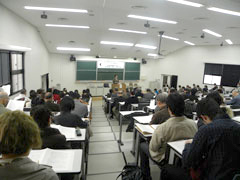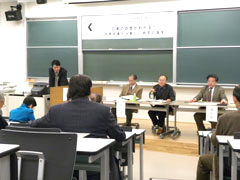Outline
Academic and Social Background
(1) Academic Background
At present, historical studies of modern Japan are increasingly passing through research steps that focus on the overall characteristics of Asian autocracy of the feudalistic states, and looking more closely into clarifying the fundamental structure of the society in Japan through integration and practical analysis of the autonomous governments that appeared in communities beginning in the 16th century. Having been entrusted with the Eisei Bunko archives, one of the best and largest collections of written articles from the daimyo and feudalistic era, the level of academic expectation from Kumamoto University both domestically and internationally is very high.
Furthermore, for a school such as ours that aspires to be a world-class research and education center, a system is required to ensure that the Eisei Bunko archives are used to their full potential as academic resources for pioneering new frontiers of interdisciplinary research in social and cultural sciences.
It is necessary that our faculty respond to these academic imperatives in a systematic manner.
(2) Social Background
As has been made evident by the increase in visitors following the renovation of Kumamoto Castle's Honmaru Goten and the popularity of the permanent Eisei Bunko display in the Kumamoto Prefectural Museum of Art, public interest in the history and culture of the Kumamoto region has been growing at an unprecedented rate in recent years following the 400 year anniversary of the construction of Kumamoto Castle. Given these circumstances and the fact that Kumamoto University oversees nearly all of the historical materials from Kumamoto's feudal era as well as the personal literary collections of generations of Kumamoto daimyo, there has been a strong directive from various organizations such as the Kumamoto Department of Cultural Affairs and the Eisei Bunko Foundation that the university take part in the planning of regional culture endeavors (including having the Eisei Bunko collection achieve national designation).
Necessity and Urgency
The aforementioned academic and social demands call for a swift and systematic response from Kumamoto University, or more specifically laying of the groundwork of a research organization for applying and analyzing the Eisei Bunko collection from a technical standpoint.
Furthermore, as the Eisei Bunko collection comprises thousands of historical documents spanning nearly every aspect of human activity from politics, economics, administration, and legislation to education, social activism, philosophy, medical and pharmaceutical sciences, architecture, and literary arts, it is clear that the creation of a center that could provide such access and analysis of the collection as a research hub for social and cultural sciences is necessary and urgent.
Summary and Features of the Center
In light of the above needs, the "Eisei-Bunko Research Center" was established in April 2009 as an organization of principally full and part-time instructors supported by part-time researchers and research assistants to meet the objectives of the Faculty of Letters.
(1) Center Services
The center performs the following services:
- 1. Services concerning the overall research of the Eisei Bunko collection.
- 2. Services concerning regional culture studies brought about by the Eisei Bunko collection.
- 3. Services concerning the enacting of cultural or creative endeavors brought about by the Eisei Bunko collection.
- 4. Services involving the support of or collaboration with cultural affairs institutions regarding studies of the Eisei Bunko collection.
- 5. Any other services necessary to meet the objectives of the center.
(2) Scholastic Study Features
Research Projects
Based on the results of projects such as Kumamoto University Core Research B, as well as goals of creating basic conditions for the study of pertinent historical articles, the center has presently settled upon the following research project plan in order to promote studies in a systematic and focused manner. Furthermore, research outcomes will also be presented regularly through cultural undertakings.
- 1. Creation of a basic catalog toward achieving a national designation for the Eisei Bunko collection.
- 2. Publication of various materials relating to Eisei Bunko.
- 3. Projects relating to the organization of core studies of the Eisei Bunko collection.
Cultural Projects
- 1. Holding public forums or extension lectures on the Eisei Bunko collection that reflect the outcomes of research projects (in cooperation with the Kumamoto Bureau of Education and Cultural Affairs).
- 2. Public exhibitions of the Eisei Bunko collection (in cooperation with the university library and the Kumamoto Prefectural Museum of Art).
- 3. Any other project that contributes to the development of regional culture brought about by the Eisei Bunko collection.


(3) Cooperation with Other Departments and Institutions
At present, the center actively promotes projects with the close cooperation of the university library that oversees the Eisei Bunko collection, the Memorial Museum of the Fifth High School as a facility and organization for exhibiting historical materials, and the Graduate School of Social and Cultural Sciences. In addition, we promote cultural projects with the cooperation of institutions such as the Kumamoto Bureau of Education and Cultural Affairs, the Kumamoto Prefectural Museum of Art, and the Kumamoto Art and Culture Association.
(4) Research Achievements
Listed below are the achievements of staff members of the Faculty of Letters as of 2009 that serve as premises for research or cultural projects organized by the center.
Major Research Achievements
- 1. Published "Kumamoto-han no Chiiki Shakai to Gyousei -Kindai Shakai Keisei no Kiten-" by YOSHIMURA Toyoo, MISAWA Jun, and INABA Tsuguharu (Shibunkaku, March 2009)
- 2. Completed the detailed Eisei Bunko "Chozai" catalog and database (March 2009)
- 3. Published the Kumamoto University Core Research Project "Higashi Asia no Bunka Kouzou to Nihon-teki Tenkai" (Kita Kyushu Chugoku Shoten, 2008)
- 4. Published "Nihon Kinsei Shakai Keisei Shiron –Sengoku Jidai-ron no Shatei-" by INABA Tsuguharu (Azekura Shobo, March 2009)
Major Cultural Project Achievements
- 1. Held the exhibition "Aso-ke Monjo Shuufuku Kansei Kinen – Aso no Bunkaisan-ten" (2006) through a joint sponsorship with Kumamoto University and the Kumamoto Prefectural Museum of Art, in which our staff played a central role in displaying the entire "Aso-ke Monjo" (an important cultural property) to a favorable response alongside lectures and guidebooks created in collaboration with curators from the museum.
- 2. Contributed to the success of the Kumamoto Prefectural Museum of Art's exhibition "Kumamoto-jou Tsuiki 400-nen Kinen – Gekido no Sandai-ten" (2007), in which our staff participated in lectures, exhibition planning, and guidebook creation, as well as worked alongside curators from the museum to select items to exhibit from the Eisei Bunko archives and write display captions and texts for the guidebooks.
![]()




